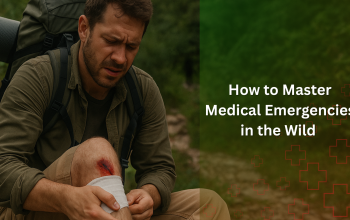A tourniquet is a device used to stop serious bleeding in the event of an injury, such as a deep cut or gunshot wound. It can be made out of almost anything, including cloth, rope, rubber bands and even sticks. In a survival situation, having a tourniquet on hand could be critical for saving the injured person.
This video gives a nice demonstration of how to put on a tourniquet in a medical emergency situation.
How to Make a Tourniquet with Materials Found in Nature
If you’re stuck in the wilderness and need to make a tourniquet, there are a few steps you can take. First, find something sturdy that can be used as a bandage, such as cloth or rope. Wrap it around the bleeding area tightly but not too tight so that blood can still get through. Then, tie a knot in the bandage. Next, you will need something to use as a stick to place over the top of the cloth and twist it until it’s tight enough to stop the bleeding. Finally, secure the stick in place with another piece of material or by tying it off so that it won’t move.
Improvisation tips for tourniquets
Here are some improvised materials for tourniquets and some additional tips to consider:
- Choosing the Right Material: When it comes to improvised materials for tourniquets, one should never use a sweater cloth as it’s too soft and won’t apply the necessary pressure. Instead, consider using pieces of clothing such as jeans or shirts.
- Jeans are Effective: Jeans are the most effective material for a tourniquet, but they are also the hardest to apply properly.
- Cutting the Material: When using a t-shirt, polo, or any other type of cloth for your tourniquet, never rip it open, but rather cut it open using scissors or a knife. Otherwise, the tourniquet might rip apart when applying torqued pressure.
- Cutting Up Jeans and T-Shirts: For jeans, cut them in half so that you’re left with one leg. Then, cut open that leg piece at the seams and twist the two ends of it to make a twirled-up jeans leg piece. For t-shirts, cut off the entire belly area horizontally, leaving only the chest and arm pieces of the shirt. Cut the rest open down the middle so that you either open the chest or back piece straight down the middle. Then, twist the two opposite ends by the arm pieces so that all the fabric is twisted up, providing more strength.
- Using Other Materials: Although wires, shoelaces, and other objects are not recommended, if nothing else is available, use them as they are better than nothing. Keep in mind that you cannot torque them as tight as you would normal materials, so make several loops around the limb before applying torque to increase the surface area of the applied pressure, thus causing less damage.
- Communicating with the Victim: Never talk to the victim about the possibility of death or how bad the injury is. The victim is likely in a state of shock and may panic if such information is shared. If they become uncomfortable and start resisting, physically hold them down rather than trying to calm them down verbally.
Dos and Don’ts of Tourniquet Use
When using a tourniquet, it’s important to remember that they should only be used as a last resort in extreme situations. When applied correctly, they can save lives, but when applied incorrectly, they can cause serious injury or worse.
Do:
– Check for a pulse before applying the tourniquet.
– Tie it as tight as you can, but not too tightly so that blood can still get through.
– Secure the stick in place with another material or by tying it off.
– Untie and loosen the tourniquet in 15 minutes and then re-tighten it.
Don’t:
– Don`t use a tourniquet if there is no life-threatening bleeding.
– Don`t leave the tourniquet on for longer than two hours.
– Don`t apply too much pressure, as this can cause nerve damage or tissue death.
– Don`t reuse an old tourniquet, as it may be contaminated with bacteria or other germs.
In a survival situation, having the knowledge to make and use a tourniquet can be essential for saving your life or someone else’s. Just remember to apply the dos and don’ts of tourniquet use, and you’ll be prepared if you ever need to use it.




